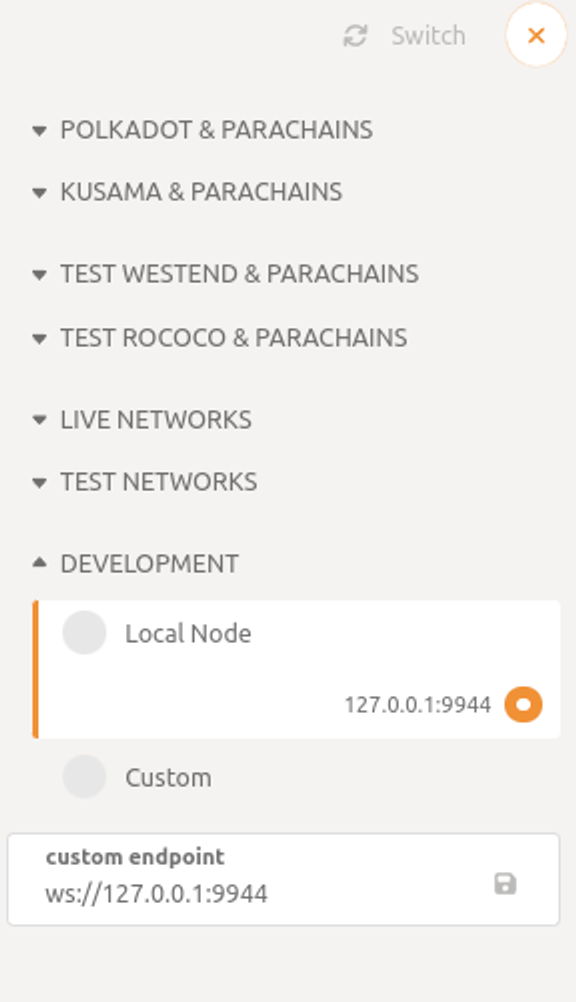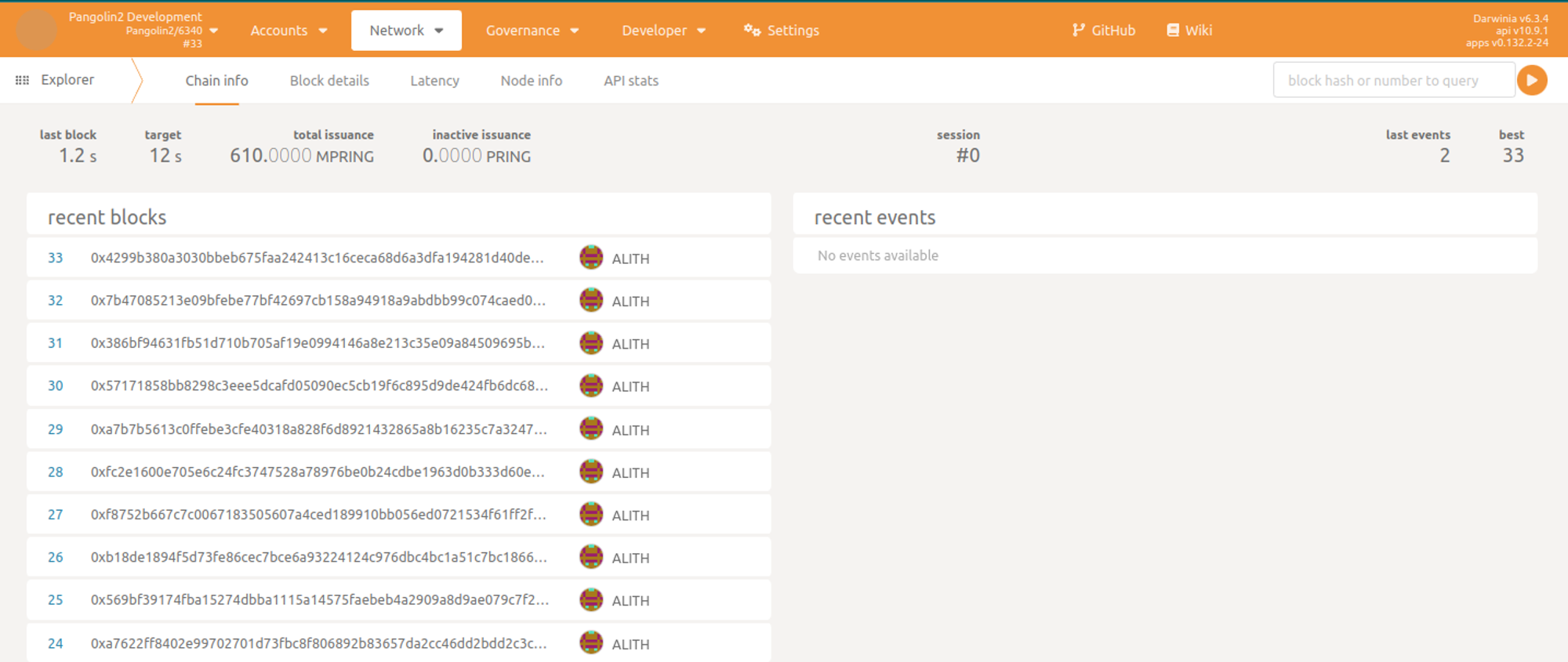Run Development Testnet¶
While there is an established test network, namely the Pangolin network, which serves as an ideal sandbox for your applications, eliminating any concern about initiating and connecting nodes, among other things. The official test network is designed to fulfill application developers' requirements. However, there may be scenarios where you want to perform low-level tasks. In such cases, creating your own development network can significantly enhance your development, testing, or debugging efficiency. This guide will walk you through the process of establishing a single-node development network.
Compile darwinia node¶
- Open a terminal shell on your computer.
-
Clone the darwinia repository by running the following command:
-
Change to the root of the repository and compile the node:
-
When the compilation is finished, something like this will be printed:
Compiling kusama-runtime v0.9.43 (https://github.com/paritytech/polkadot?branch=release-v0.9.43#ba42b9ce) Compiling rococo-runtime v0.9.43 (https://github.com/paritytech/polkadot?branch=release-v0.9.43#ba42b9ce) Compiling polkadot-runtime v0.9.43 (https://github.com/paritytech/polkadot?branch=release-v0.9.43#ba42b9ce) Compiling darwinia-runtime v6.3.4 (/home/bear/coding/rust-space/darwinia/runtime/darwinia) Compiling crab-runtime v6.3.4 (/home/bear/coding/rust-space/darwinia/runtime/crab) Compiling pangolin-runtime v6.3.4 (/home/bear/coding/rust-space/darwinia/runtime/pangolin) Compiling darwinia v6.3.4 (/home/bear/coding/rust-space/darwinia/node) Compiling polkadot-client v0.9.43 (https://github.com/paritytech/polkadot?branch=release-v0.9.43#ba42b9ce) Compiling polkadot-service v0.9.43 (https://github.com/paritytech/polkadot?branch=release-v0.9.43#ba42b9ce) Compiling polkadot-cli v0.9.43 (https://github.com/paritytech/polkadot?branch=release-v0.9.43#ba42b9ce) Compiling cumulus-relay-chain-inprocess-interface v0.1.0 (https://github.com/paritytech/cumulusbranch=polkadot-v9.43#b8999fce) Compiling cumulus-client-service v0.1.0 (https://github.com/paritytech/cumulus?branch=polkadot-v0.9.43#b8999fce) Finished release [optimized] target(s) in 5m 57s
Start the development node¶
After your node compiles, you are ready to start exploring what it does using the darwinia development node.
To start the local Substrate node:
-
In the same terminal where you compiled your node, you can now start the node in development mode by running the following command:
The darwinia command-line options specify how you want the running node to operate. In this case, the
--devoption specifies that the node runs in development mode using the predefineddevelopmentchain specification. By default, this option also deletes all active data—such as keys, the blockchain database, and networking information when you stop the node by pressing Control-c. Using the--devoption ensures that you have a clean working state any time you stop and restart the node. -
Verify your node is up and running successfully by reviewing the output displayed in the terminal. The terminal should display output similar to this:
2023-07-19 17:28:48 Darwinia 2023-07-19 17:28:48 ✌️ version 6.3.4-93d2e8acc04 2023-07-19 17:28:48 ❤️ by Darwinia Network <hello@darwinia.network>, 2018-2023 2023-07-19 17:28:48 📋 Chain specification: Pangolin2 Development 2023-07-19 17:28:48 🏷 Node name: Alice 2023-07-19 17:28:48 👤 Role: AUTHORITY 2023-07-19 17:28:48 💾 Database: RocksDb at /tmp/substrate2cWt4x/chains/pangolin2-development/db/full 2023-07-19 17:28:48 ⛓ Native runtime: Pangolin2-6340 (DarwiniaOfficialRust-0.tx0.au0) 2023-07-19 17:28:49 [pallet::staking] assembling new collators for new session 0 at #0 2023-07-19 17:28:49 [pallet::staking] assembling new collators for new session 1 at #0 2023-07-19 17:28:49 Parachain id: Id(2105) 2023-07-19 17:28:49 Parachain Account: 5Ec4AhNxga1JYLioRBNxfRnovheDELVbZTRSnKMgvSVPvNcN 2023-07-19 17:28:49 Parachain genesis state: 0x0000000000000000000000000000000000000000000000000000000000000000002c5871dbc5c80fec32f7372f029e271039a29c91b5ad4b0d286277de0daa05b203170a2e7597b7b7e3d84c05391d139a62b157e78786d8c082f29dcf4c11131400 2023-07-19 17:28:49 Is collating: yes 2023-07-19 17:28:49 [pallet::staking] assembling new collators for new session 0 at #0 2023-07-19 17:28:49 [pallet::staking] assembling new collators for new session 1 at #0 2023-07-19 17:28:50 🔨 Initializing Genesis block/state (state: 0xb1f3…1cda, header-hash: 0x040e…561a) 2023-07-19 17:28:51 🏷 Local node identity is: 12D3KooWPPLzbofiQNjSiW6CmzPmQQkaWGvUuLXjHeDc5BiwgwXE 2023-07-19 17:28:51 💻 Operating system: linux 2023-07-19 17:28:51 💻 CPU architecture: x86_64 2023-07-19 17:28:51 💻 Target environment: gnu 2023-07-19 17:28:51 💻 CPU: AMD Ryzen 7 5700G with Radeon Graphics 2023-07-19 17:28:51 💻 CPU cores: 8 2023-07-19 17:28:51 💻 Memory: 63586MB 2023-07-19 17:28:51 💻 Kernel: 5.19.0-46-generic 2023-07-19 17:28:51 💻 Linux distribution: Ubuntu 22.04.1 LTS 2023-07-19 17:28:51 💻 Virtual machine: no 2023-07-19 17:28:51 📦 Highest known block at #0 2023-07-19 17:28:51 〽️ Prometheus exporter started at 127.0.0.1:9615 2023-07-19 17:28:51 Running JSON-RPC server: addr=127.0.0.1:9944, allowed origins=["http://localhost:*", "http://127.0.0.1:*", "https://localhost:*", "https://127.0.0.1:*", "https://polkadot.js.org"] 2023-07-19 17:28:56 💤 Idle (0 peers), best: #0 (0x040e…561a), finalized #0 (0x040e…561a), ⬇ 0 ⬆ 0If the number after
finalizedis increasing, your blockchain is producing new blocks and reaching consensus about the state they describe. -
Keep the terminal that displays the node output open to continue.
Connected to the Polkadot App¶
Once the node is up and producing new blocks, you can connect to the Polkadot app to explore more advanced features, such as token transfer and more.

